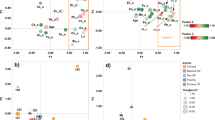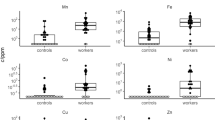Summary
A small group (n=12) of military white smok munition workers provided blood plasma during a production break (S I) and after five weeks' production (S II) of a hexachloroethane (HCE)/titanium dioxide formula. Plasma was also obtained from a sex and age matched control group (n=12) and a group (n=13) of previously HCE-exposed workers, respectively. HCE in plasma (P-HCE) was determined with gas chromatography and electron capture detection. No HCE was found in the plasma samples from the two control groups. In the HCE exposed group the mean (± SD) P-HCE level increased almost two orders of magnitude from S I (0.08 t 0.14 μg/l) to S 11(7.30 ± 6.04μg/l) despite efforts to minimize the internal dose. Biological monitoring of HCE could be useful in occupational hygiene.
Similar content being viewed by others
References
American Conference of Governmental Industrial Hygienists (1991) Threshold limit values for chemical substances and physical agents and biological exposure indices for 1991–92. ACGIH, Cincinnati
Blount BW (1990) Two types of metal fume fever. Mild vs serious. Military Med 155:372–377
Eastin Jr WC (1988) Toxicologic and carcinogenic effects of hexachloroethane exposure to F 344/N rats. Proc Am Assoc Cancer Res 30:115 (abstract)
Homung RW, Reed ID (1990) Estimation of average concentration in the presence of nondetectable values. Appl Occup Environ Hyg 5:46–51
International Agency for Research on Cancer (1979) Hexachloroethane. IARC Monographs on the Evaluation of the Carcinogenic Risk of Chemicals to Humans 20:467–476
Karlsson N, Cassel G, Fängmark I, Bergman F (1986) A comparative study of the acute inhalation toxicity of smoke from TiO2-hexachloroethane and Zn-hexachloroethane pyrotechnic mixtures. Arch Toxicol 59:160–166
Mersch-Sundermann V (1989) Examination of mutagenicity of organic microcontaminants on the environment. II. Communication: The mutagenicity of halogenated aliphatic hydrocarbons with the Salmonella-microsome-test (Ames-test) as to contamination of ground- and drinking-water. Zentralbl Bakteriol Mikrobiol Hyg 187:230–243
Milman HA, Story DL, Riccio ES, Sivak A, Tu AS, Williams GM, Tong C, Tyson CA (1988) Rat liver foci and in vitro assays to deter initiating and promoting effects of chlorinated ethanes and ethylenes. Ann NY Acad Sci 534:521–530
Nordell K (1978) Sampling and analysis of hexachlorocthane in air. Method M77-1402-9132 (in Swedish). FFV Materialteknik, Linköping, 2 pp
Town C, Leibman KC (1984) The in vitro dechlorination of some polychlorinated ethanes. Drug Metab Dispos 12:4–8
Weeks MH, Angerhofer RA, Bishop R, Thomasino J, Pope CR (1979) The toxicity of hexachloroethane in laboratory animals. Am Ind Hyg Assoc J 40:187–199
Author information
Authors and Affiliations
Rights and permissions
About this article
Cite this article
Seldén, A., Nygren, M., Kvarnlöf, A. et al. Biological monitoring of hexachloroethane. Int. Arch Occup Environ Heath 65 (Suppl 1), S111–S114 (1993). https://doi.org/10.1007/BF00381319
Issue Date:
DOI: https://doi.org/10.1007/BF00381319




